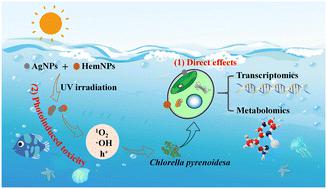当前位置:
X-MOL 学术
›
Environ. Sci.: Nano
›
论文详情
Our official English website, www.x-mol.net, welcomes your
feedback! (Note: you will need to create a separate account there.)
Mechanisms of photoinduced toxicity of AgNPs to the microalgae Chlorella pyrenoidosa in the presence of hematite nanoparticles: insights from transcriptomics, metabolomics and the photochemical index
Environmental Science: Nano ( IF 5.8 ) Pub Date : 2022-08-05 , DOI: 10.1039/d2en00450j Manman Cao 1, 2 , Fei Wang 1 , Beihai Zhou 2 , Huilun Chen 2 , Rongfang Yuan 2 , Shuai Ma 2 , Huanhuan Geng 2 , Baoshan Xing 3
Environmental Science: Nano ( IF 5.8 ) Pub Date : 2022-08-05 , DOI: 10.1039/d2en00450j Manman Cao 1, 2 , Fei Wang 1 , Beihai Zhou 2 , Huilun Chen 2 , Rongfang Yuan 2 , Shuai Ma 2 , Huanhuan Geng 2 , Baoshan Xing 3
Affiliation

|
Silver nanoparticles (AgNPs) have little impact on organisms at environmentally relevant concentrations. However, AgNPs coexisting with photoactive minerals may show an elevated combined ecotoxicity due to the additional photoinduced cytotoxicity caused by the Ag loading, which increases the photocatalytic activity. Herein, key pathway perturbations in the algae Chlorella pyrenoidosa (C. pyrenoidosa) under exposure to AgNPs, hematite nanoparticles (HemNPs), and their mixtures (direct exposure (MX1) and exposure after interaction (MX2)) were explored under illumination using transcriptomic and metabolomic approaches. The results showed that the MX2 group exhibited the strongest C. pyrenoidosa growth inhibition. The AgNPs, HemNPs, MX1 and MX2 groups significantly triggered ROS production in algal cells, which increased by 11.05%, 5.54%, 4.79% and 13.58%, respectively. Notably, the cell membrane was obviously damaged only in the MX2 group. Transcriptomic and metabolomic analyses showed that metabolic pathways, such as starch and sucrose metabolism, pantothenate and CoA biosynthesis, and amino acid metabolism, were significantly altered. To examine the internal mechanisms behind these differences in genes and metabolites, ultraviolet–visible (UV–vis) diffuse reflectance spectroscopy, electrochemical impedance spectroscopy (EIS) and photocurrent response measurements were used to determine the photochemical properties of the four systems. AgNPs attachment enhanced the photoelectric properties of the AgNPs/HemNPs composite (MX2), improving the photoinduced electron–hole pair separation efficiency and charge separation efficiency. Electron paramagnetic resonance (EPR) results also showed that the MX2 system yielded the highest amount of free radicals. Free radicals caused photoinduced cytotoxicity in algae, leading to aggravated toxicity of AgNPs to C. pyrenoidosa in the presence of HemNPs.
中文翻译:

在赤铁矿纳米颗粒存在下,AgNPs 对微藻小球藻的光致毒性机制:转录组学、代谢组学和光化学指数的见解
银纳米粒子 (AgNPs) 在环境相关浓度下对生物体几乎没有影响。然而,由于 Ag 负载引起的额外光诱导细胞毒性,与光活性矿物共存的 AgNPs 可能显示出升高的组合生态毒性,这增加了光催化活性。在此,在光照下使用转录组学和转录组学研究了暴露于 AgNPs、赤铁矿纳米粒子 (HemNPs) 及其混合物(直接暴露 (MX1) 和相互作用后暴露 (MX2))的藻类小球藻( C. pyrenoidosa )中的关键通路扰动。代谢组学方法。结果表明,MX2 组表现出最强的C. pyrenoidosa生长抑制。AgNPs、HemNPs、MX1 和 MX2 组显着触发藻细胞中 ROS 的产生,分别增加了 11.05%、5.54%、4.79% 和 13.58%。值得注意的是,只有MX2组的细胞膜明显受损。转录组学和代谢组学分析表明,淀粉和蔗糖代谢、泛酸和辅酶A生物合成以及氨基酸代谢等代谢途径发生了显着变化。为了检查基因和代谢物这些差异背后的内部机制,使用紫外-可见 (UV-vis) 漫反射光谱、电化学阻抗谱 (EIS) 和光电流响应测量来确定四个系统的光化学性质。AgNPs 附着增强了 AgNPs/HemNPs 复合材料 (MX2) 的光电性能,提高光致电子-空穴对分离效率和电荷分离效率。电子顺磁共振 (EPR) 结果还表明,MX2 系统产生的自由基量最高。自由基在藻类中引起光诱导细胞毒性,导致 AgNPs 对C. pyrenoidosa在 HemNPs 存在下。
更新日期:2022-08-05
中文翻译:

在赤铁矿纳米颗粒存在下,AgNPs 对微藻小球藻的光致毒性机制:转录组学、代谢组学和光化学指数的见解
银纳米粒子 (AgNPs) 在环境相关浓度下对生物体几乎没有影响。然而,由于 Ag 负载引起的额外光诱导细胞毒性,与光活性矿物共存的 AgNPs 可能显示出升高的组合生态毒性,这增加了光催化活性。在此,在光照下使用转录组学和转录组学研究了暴露于 AgNPs、赤铁矿纳米粒子 (HemNPs) 及其混合物(直接暴露 (MX1) 和相互作用后暴露 (MX2))的藻类小球藻( C. pyrenoidosa )中的关键通路扰动。代谢组学方法。结果表明,MX2 组表现出最强的C. pyrenoidosa生长抑制。AgNPs、HemNPs、MX1 和 MX2 组显着触发藻细胞中 ROS 的产生,分别增加了 11.05%、5.54%、4.79% 和 13.58%。值得注意的是,只有MX2组的细胞膜明显受损。转录组学和代谢组学分析表明,淀粉和蔗糖代谢、泛酸和辅酶A生物合成以及氨基酸代谢等代谢途径发生了显着变化。为了检查基因和代谢物这些差异背后的内部机制,使用紫外-可见 (UV-vis) 漫反射光谱、电化学阻抗谱 (EIS) 和光电流响应测量来确定四个系统的光化学性质。AgNPs 附着增强了 AgNPs/HemNPs 复合材料 (MX2) 的光电性能,提高光致电子-空穴对分离效率和电荷分离效率。电子顺磁共振 (EPR) 结果还表明,MX2 系统产生的自由基量最高。自由基在藻类中引起光诱导细胞毒性,导致 AgNPs 对C. pyrenoidosa在 HemNPs 存在下。











































 京公网安备 11010802027423号
京公网安备 11010802027423号